A rectangular flat water tank is placed on the roof of a house with its lower portion perfectly insulated. A sheet of glass whose transmission characteristics are tabulated below is placed 1 cm above the water surface. Assuming that the average incident solar radiation is 630 W/m2, calculate the equilibrium water temperature for a water depth of 12 cm if the heat transfer coefficient at the top of the glass is 8.5 W/(m2 K) and the surrounding air temperature of 20°C. Disregard intereflections.

GIVEN
- A glass covered water tank on the roof of a house
- Lower portion of tank is perfectly insulated
- Distance between glass cover and water surface

- Average incident solar radiation (Is) = 630 W/m2
- Water depth = 12 cm = 0.12 m
- Heat transfer coefficient on the top of the glass (hco) = 8.5 W/(m2 K)
- Surrounding air temperature (T?)
- Transmissivity of glass (??)

- Reflectivity of Glass (p?) = 0.08
FIND
- The equilibrium temperature of the water (Tw)
ASSUMPTIONS
- The effect of inter-reflections is negligible
- The water temperature is uniform (internal resistance of the water is negligible)
- Steady state conditions
- Is value given is normal to the glass surface
- The water absorbs all the radiation reaching it
- Water behaves as a blackbody
- The conductive thermal resistance of the glass is negligible
- The sky behaves as a blackbody enclosure at Tsky = 0 K
- The sun is blackbody at 6000 K (see Table 9.2)
- The shape factor between the surface and the glass can be taken to be unity
- The air properties are the same as dry air properties
- The glass acts as a black surface for the reradiated energy
SKETCH

PROPERTIES AND CONSTANTS
the Stephan-Boltzmann constant (?)= 5.67 x 10–8 W/(m2 K4)
The thermal circuit for the problem is shown below

where
qr = radiative heat transfer flux
qc = convective heat transfer flux
qs = solar radiation
The radiative heat transfer from the water through the glass to the sky (qrw,sky) = 0 because the majority of the radiation from the water will be at long wavelengths for which the transmissivity of the glass is zero.
An expression can be written for each of the heat fluxes
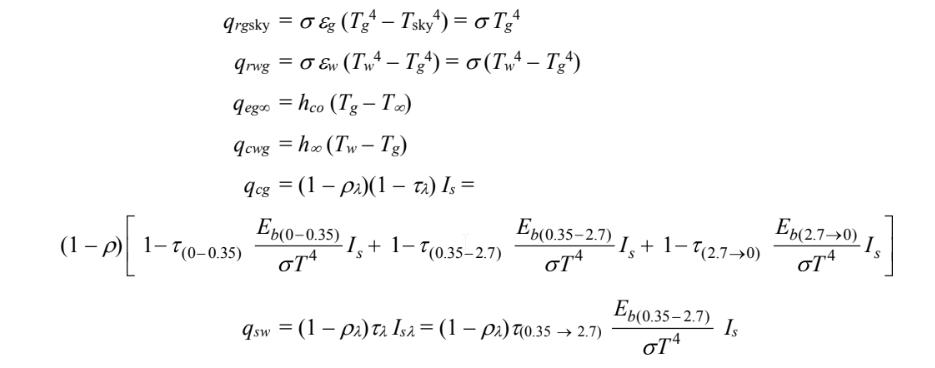
Only the last two expressions are frequency dependent.
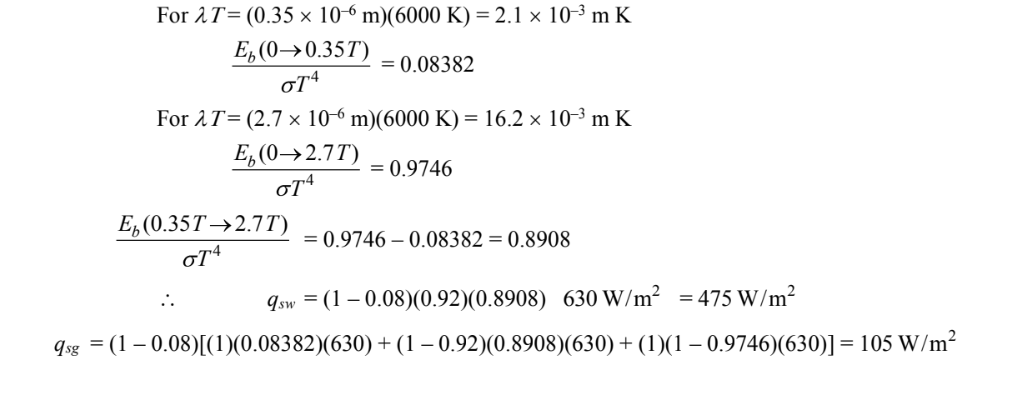
The natural convection Nusselt number between the glass and water is

where the notation [ ]· indicates that if the quantity inside the brackets is negative, the quantity is to be taken as zero. The Rayleigh number is given by

Since both Tw and Tg are unknown, an iterative solution must be used. For the first iteration, let
Tw = 80°C and Tg = 40°C.
for dry air at the average temperature of (Tw + Tg)/2 = 60°C
Thermal expansion coefficient = 0.00300 1/K
Thermal conductivity (k) = 0.0279 W/(m K)
Kinematic viscosity (v) = 19.4 x 10–6 m2/s
Prandtl number (Pr) = 0.71
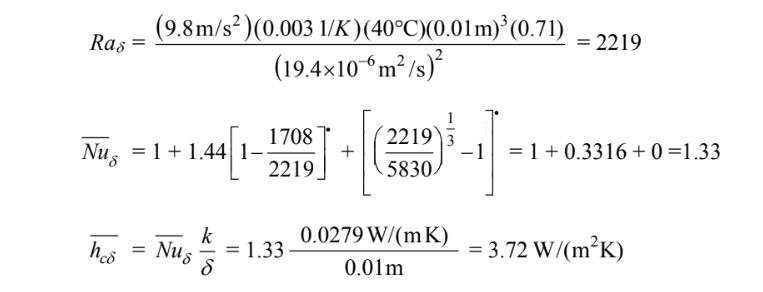
An energy balance on the glass plate yields

Rearranging

where
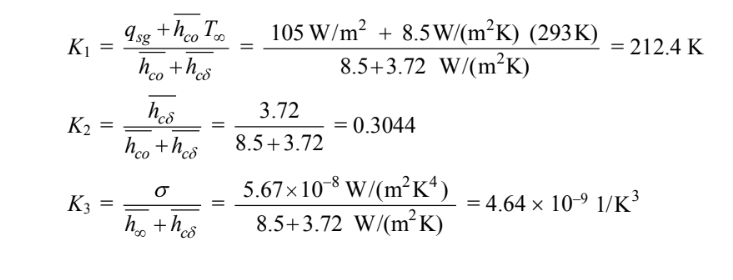
An energy balance on the water yields

Rearranging

where

These two simultaneous 4th order equations may by solved iteratively as follows:
1. Guess values of Tw and Tg
2. Iterative equation [2] to generate a new value of Tw
3. Using this value of Tw, iterate equation [1] to generate a new rate for Tg.
4. Repeat the procedure until the difference between the values of Tw and Tg for successive iterations
is below a chosen tolerance.
This procedure is implemented in the Pascal program shown below
var
Tw1,Tw,Tg1,Tg,Diff_g,Diff_w:real;
Const
K1 = 212.4;
K2 = 0.3044;
K3 = 4.64E-9;
K4 = 127.7;
K5 = 1.524E-8;
gain = 0.4;
Begin
{Let Tw1 = 353 K and Tg1 = 313 K be the initial guesses}
Tw:=0.0;
Tg:=0.0;
Tw1:=353.0;
Tg1:=313.0;
Repeat
Repeat
{Iterate equation [2] to calculate a new Tw}
Tw:=K4 – K5*(Tw1*Tw1* Tw1* Tw1 – Tg1* Tg1* Tg1* Tg1)+ Tg1;
Diff_w:=Tw-Tw1;
Tw1:=Tw1+gain*Diff_w;
Until abs(Diff_w) < 0.1;
Repeat
{Iterate equation [1] to calculate a new Tg}
Tg:=K1 + K2*Tw + K3*(Tw* Tw* Tw* Tw – 2.0*Tg1* Tg1* Tg1 Tg1);
Diff_g:=Tg-Tg1;
Tg1:=Tg1+gain*Diff_g;
Until abs(Diff_g) < 0.1;
Tw:=K4 – K5*(Tw1* Tw1* Tw1* Tw1* – Tg1* Tg1* Tg1* Tg1*) + Tg1;
Diff_w:=abs(Tw-Tw1);
Tw1:=Tw;
Until Diff_w < 0.1;
Writeln(‘ Tw = ',Tw:6.1, K Tg = ,Tg:6.1,' ' K');
end.
(Note: the gain factor slows down the convergence but is often necessary for non-linear problems) The output from the first run of this program is

These values are different enough from the initial guesses that another iteration will be performed:
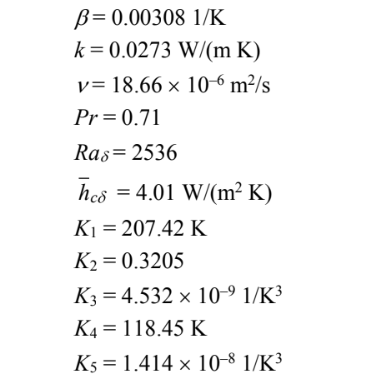
Running the program again, the new constants and the above temperatures as the initial guesses yields:

The water temperature is approximately 71.5°C.
You might also like to view...
The concept of entropy tells us how exothermic reactions are
A) favored over endothermic reactions. B) not as favorable as endothermic reactions. C) just as effective as endothermic reactions. D) the reverse of endothermic reactions.
How much charge must pass by a point in a wire in 10 s for the current through the wire to be 0.50 A?
A) 20 C B) 2.0 C C) 5.0 C D) 0.050 C
An induced emf is produced in
a. a closed loop of wire when it remains at rest in a nonuniform static magnetic field. b. a closed loop of wire when it remains at rest in a uniform static magnetic field. c. a closed loop of wire moving at constant velocity in a nonuniform static magnetic field. d. all of the above. e. only (b) and (c) above.
For general projectile motion, the horizontal component of a projectile's velocity
A) is zero. B) remains a non-zero constant. C) continuously increases. D) continuously decreases. E) any of the above, depending on position.